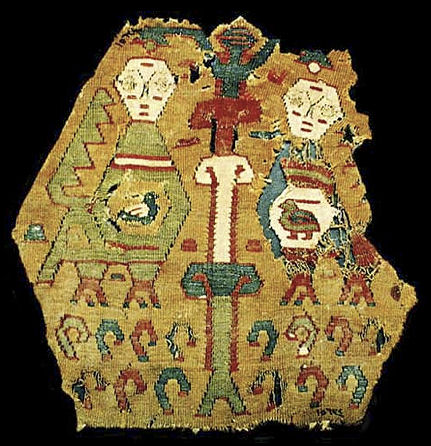|
Members
Join Date: Jul 2008
Location: France
Posts: 10
|

Hello guys,
Have a look at this catalogue description, please:
In the 1990s a very small group of rugs appeared on the market, all of which were said to come from Tibet. They were very comparable in design and colouring, and all had very similar structure. They caused huge excitement when they were first published since they were thought to be original examples of rugs that were only known beforehand in European paintings. The majority of them have highly stylised animals that each has a further animal inside. One, the largest, formerly in the Kirchheim Collection, is now in the Museum of Islamic Art, Qatar (Heinrich E. Kirchheim et al., Orient Stars, A Carpet Collection, Stuttgart and London 1993, pp.14 and 15); the second is in the Metropolitan Museum of Art (David Roxburgh, Turks, exhibition catalogue, London, 2005, pl.98, p.143). Jon Thompson lists a further example in a private collection in Genova, another unpublished three fragments from a large carpet with prancing horses in the Kirchheim Collection, and a small fragment in the Pine Collection (list from Jon Thompson, 'Carpets in the Fifteenth Century', in Carpets and Textiles in the Iranian World 1400-1700, London, 2010, note 54, p.57). The Genoa example is published in black and white by Jürg Rageth, Anatolian kilims and radiocarbon dating, Riehen 1999, fig.9, p.166.
(...)
The Metropolitan rug has been carbon 14 dated to 1040-1290 AD; the Qatar carpet to 1190-1300, and the Italian rug to 1205-1375. These results are all consistent and would support a date of almost anywhere in the 13th century. The fourth carpet however, that remaining in the Kirchheim collection, has been carbon dated with a result that indicates a date of 1308-1420.
(...)
Julia Bailey was the first person to suggest in print that these carpets, which had all been catalogued as Turkish, were in fact Persian, citing the similarity of an illustration in the Great Mongol Shahnama to the design of these carpets (Julia Bailey, 'Milestones in the History of Carpets', Hali 152, summer 2007, pp,140-143). Jon Thompson has recently returned to this theme, illustrating the Shahnama illustration (Thompson, op. cit., pp.50-52). Not only is the field design very similar, but there is an inner border showing that is almost identical to that on the three rugs noted above. There seems little doubt that it is one of this group of carpets that is depicted. The only question is whether it is of local manufacture, or an import
The Great Mongol Shahnama was dispersed in the early 20th century by the Belgian dealer Georges Demotte. Nothing remains of the colophon which might have given information about when and where, and for whom, it was created. Scholars are however relatively united in dating it to the second quarter of the 14th century, most concurring with the attribution suggested by Oleg Grabar and Sheila Blair who argued that it was made for Ghiyath al-Din b. Humam al-Din Muhammad, the son of Rashid al-Din, the Ilkhanid vizier who was based in Tabriz, in around 1335. The carpets thus pre-date this, which is consistent with the carbon date results on the three "pregnant animal" carpets noted above. Even the early part of the dating on the Kirchheim carpet is entirely consistent with a date in the first quarter of the 14th century. The combination of pictorial and scientific evidence strongly indicates that this is the remains of a royal Ilkhanid carpets, probably from Tabriz, a remarkable survival.
Have also a look at this picture:
 Source The Weaving Art Museum and Research Institute
Source The Weaving Art Museum and Research Institute
Technical Analysis
Cairo Inv No IM 15634
Size: 13 inch x 14.5 inch
Warp: Wool, Z2S 16 per inch
Weft: Wool with areas of white cotton, 64-112 weft per inch
Structure: slit-tapestry
Any thought?
All the best,
Y 
Last edited by Filiberto Boncompagni; March 24th, 2011 at 01:26 PM.
|